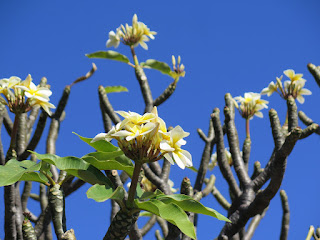Being in the tropics is interesting for lots of reasons, but the lush vegetation certainly seems to transport you to a different place. Most of the vegetation that we are most familiar with is not native, including the coconut palms that were introduced hundreds of years ago by the first settlers from Polynesia.
Although they are non-native, it is always a joy to see the beautiful and fragrant blossoms of Plumeria (also known as frangipani). Some days we see people out picking the blossoms to make leis. This time of year, we often see trees without any leaves that are loaded with blossoms.
 |
| A leafless Plumeria tree |
Another non-native flower that is growing all over the place is Bougainvillea. These come in several colors, and the color comes from modified leaves called bracts. The bracts surround their tiny, white flowers.
 |
| The pigmented bracts surrounding the Bougainvillea flowers |
This morning, as I was walking along the old airport beach, I found a group of ukulele enthusiasts playing under a shade tree. They were playing "You are my sunshine."
Enjoy the sunshine and all it brings.


















































